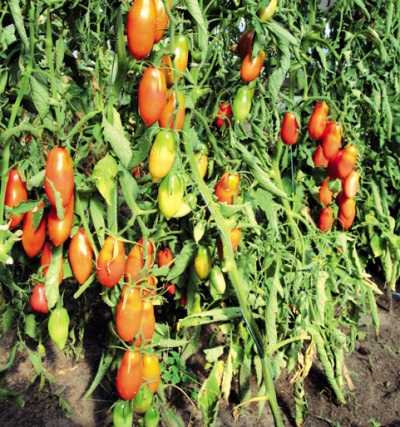
- Authors: Siberian selection
- Category: grade
- Growth type: indeterminate
- Appointment: fresh consumption, for pickling and canning, for ketchup and tomato paste
- Ripening period: mid-early
- Ripening time, days: 110-115
- Growing conditions: for open ground, for greenhouses
- Transportability: high
- Bush size: tall
- Bush height, cm: 150-250
Tomato Uncle Stepa is a very popular tomato variety among summer residents. It can be used for home furnishings as well as for sale. Due to its high transportability and keeping quality (up to 75 days, and in the refrigerator up to 90), it is grown on an industrial scale on special agricultural farms.
Breeding history
First bred by breeders in Siberia in 2008. Included in the State Register in 2012. It was created for cultivation both in greenhouses and in the open field.
Description of the variety
This type of tomato is indeterminate and continues to grow throughout its life. It can reach from 1.5 to 2.5 meters, depending on the landing site. The foliage on the plant is evenly distributed. When flowering, the bush is covered with simple inflorescences.
The main qualities of the fruit
Uncle Styopa bears fruit with rather large bright red tomatoes. They are elongated in shape with a pointed tip and have an oval cross-section. The weight of one fruit can reach 180-300 grams. From 3 to 5 tomatoes are formed on one brush. The pulp of this variety contains almost no juice, it is starchy and dense in consistency. The skin of the fruit is thin, but dense, not prone to cracking. There are few seed chambers in tomatoes, about 3-5.
Taste characteristics
These tomatoes taste sweet. They make excellent salads, as well as pastas and sauces. They are not suitable for juicing.
Ripening and fruiting
Tomato Uncle Stepa is considered a mid-early variety in terms of ripening. From germination to fruiting, 110-115 days pass. Full maturation begins in July. Harvesting is carried out from the end of summer and throughout September.
Yield
It has a fairly abundant fruiting. You can harvest up to 8 kg from one plant. And also this variety is very transportable, which allows you to grow it for sale in large volumes.
The timing of planting seedlings and planting in the ground
After preparing the seeds, they are planted in trays with peat. This is best done in March or April. Depends on the selected place of planting seedlings (in a greenhouse or in open ground). When the first large leaves appear at the seedlings, it is necessary to carefully monitor the small plants and water in a timely manner. After the appearance of at least 3 solid leaves, the seedlings can be planted in the soil. This usually happens in May-June.

Growing tomato seedlings is an extremely important process, because it largely depends on whether the gardener will be able to harvest at all. All aspects must be taken into account, from seedbed preparation to planting in the ground.
Landing scheme
When planting seedlings in the ground, it is necessary to take into account the plant rate per 1 square meter. For this variety, it is equal to 5 plants.

Growing and care
In addition to standard care, this species requires several additional procedures due to its distinctive characteristics.
Molding. Required due to the spreading of the bush. Only two powerful stems should be left.
Steying. It is necessary to remove some buds and extra stepchildren in order to stop the plant from growing and direct the forces to the harvest. And you also need to normalize the load on the bush.
Garter. Due to the high growth of the plant, it is tied to a support in order to minimize the load from the weight of the fruit, and to prevent the tomato from breaking and falling.




A plant needs different micronutrients at each stage of growth. All fertilizers can be divided into two groups: mineral and organic. Folk remedies are often used: iodine, yeast, bird droppings, eggshells.
It is important to observe the rate and period of feeding. This also applies to folk remedies and organic fertilizers.


Resistant to adverse weather conditions
Bred for growing in areas with a variable climate. It tolerates temperature changes well. Able to ripen in both hot and cool weather conditions.
Growing regions
Since this variety was born in Siberia, it is suitable for very harsh climatic conditions. It will take root well in the Non-Black Earth Region and in the Far East. But in the southern regions of Russia, it will bear fruit perfectly.
Review overview
In all reviews of this variety, its unpretentiousness in care is mentioned. As well as large size and weight. Many praise its aromatic, sweet taste. And it is recommended for use in canning. Namely: for making lecho and tomato paste.

























































































